This post contains affiliate links.
California is home to numerous hummingbirds both year-round and seasonal. There are even a few species of hummingbirds that are rarely only found in California as exotic visitors.
While it is easy to assume all hummingbirds are the same when we rarely see them as more than a jewel-toned flashing blur as they jet around our hanging flowers and porches; they reside in different geographic ranges, temperaments, varied nesting habits, and diverse coloring.
What types of hummingbirds are found in California?
- There are 14 species of hummingbirds found in California.
- Year-round natives: Anna’s, Allen’s, Calliope.
- Seasonal: Black-chinned, Rufous, Costas, Green-violetears, Violet-crowned.
- Rare: Broad-billed, Xantus, Blue-throated, Rivolis, Ruby-throated and Broad-tailed.
Hummingbirds are known to exist within certain established ranges, either as year-round natives or as part of a migratory cycle.
While there are species of hummingbirds as year-round natives of California as well as seasonal visitors, there are hummingbirds found rarely in California and show up at feeders far outside their established range. These hummingbirds are known in ornithological circles as “vagrants.”
Categories of Hummingbirds:
Year-round/Native Hummingbirds: These hummingbirds live in California year-round and do not migrate.
- Anna’s
- Allen’s
- Calliope
Seasonal Hummingbirds: These hummingbirds are in California temporarily as part of their migratory pattern.
- Black-chinned
- Rufous
- Costas
- Green-violetears
- Violet-crowned
Rare/Vagrant Hummingbirds: These hummingbirds are outside of their normal geographic range when found in California but are occasionally spotted. Not only do these species of hummingbirds have a wide variety of specific geographic ranges, they are also known to sometimes interbreed with each other, creating hybrids.
- Broad-billed
- Xantus
- Blue-throated
- Rivolis
- Ruby-throated
- Broad-tailed
Because of human intervention, in the form of feeding stations and the transplant of exotic flowers in residential areas, some hummingbirds in mild climates are staying rather than migrating.
Read on to find out more about each of these hummingbird species as well as where and when they can be found in California.
Year-Round/Native Hummingbirds:
Anna’s Hummingbird – (Calypte anna)
Conservation Status: Least concerned
Kingdom: Animalia
Phylum: Chordata
Class: Aves
Order: Apodiformes
Family: Trochilidae
Genus: Calypte
Species: C. anna
Native to California, the Anna’s hummingbirds are named after Anna Massena, Duchess of Rivoli. Their size ranges from 3.5 inches to 4.3 inches in length.
Male Anna’s hummingbirds are the only hummingbird species in North America with a red crown. They are identified as mostly green, gray, and magenta in color. The males have flashier, more colorful iridescent magenta gorget and crown (the showy patch of color over a hummingbird’s throat, common in many species).
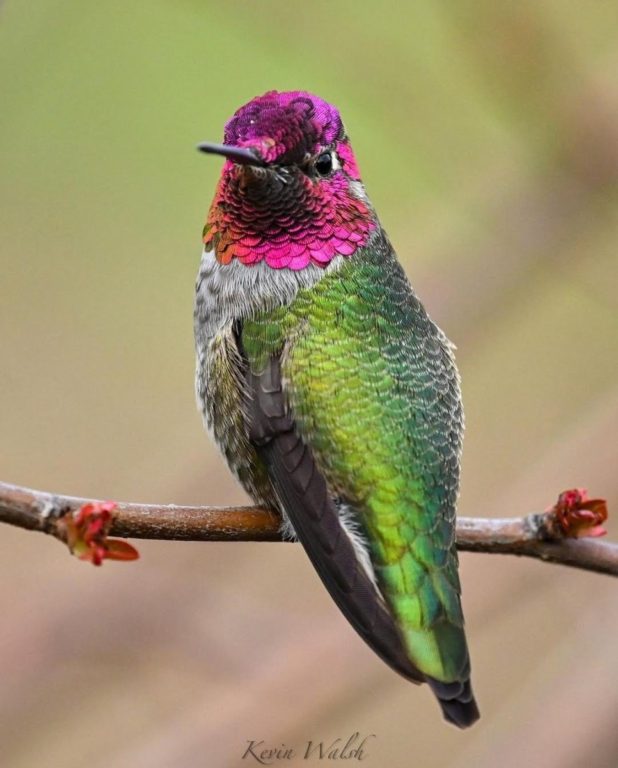
Photo by: Kevin Walsh

Photo by: rwm_inthewild
Taken: Stanford Dish Trail, CA
The gorget of a hummingbird is named after the protective metal piece in a suit of armor that covers the wearer’s throat to prevent injury when in battle. Since male hummingbirds are very aggressive with each other when fighting for their own territory, this name is appropriate and fitting to describe their physical attributes.
Female Anna’s hummingbirds can also have a gorget, but it is a smaller patch of magenta. The females are overall not as colorful as the males and are a paler color of green. Females tend to have a pale white line over each eye that makes them distinctive.
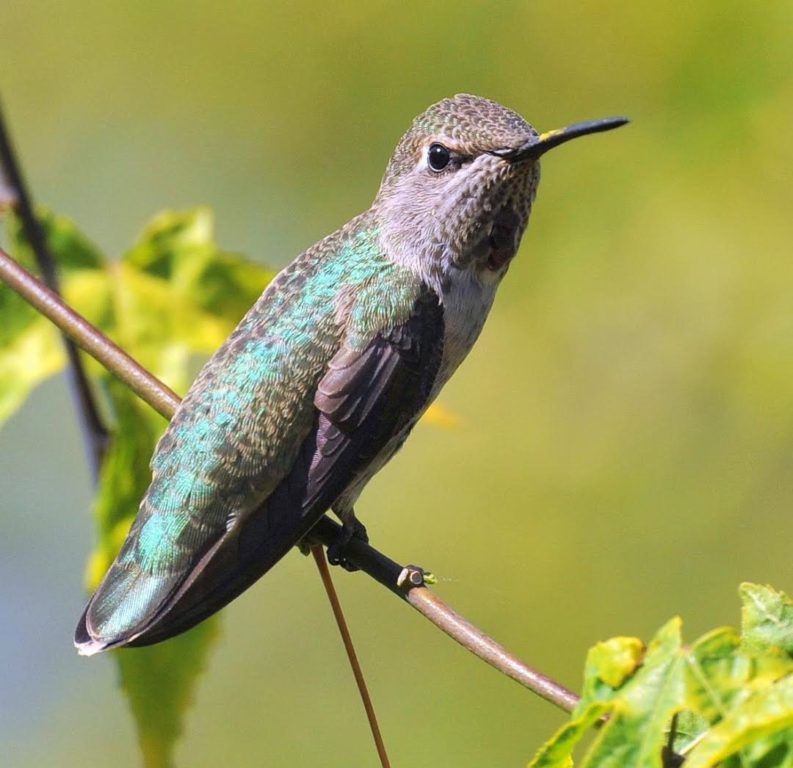
Photo by: rwm_inthewild
Taken: Gamble Garden, CA

Photo by: Kevin Walsh
Note: This Anna’s hummingbird could be a juvenile in those awkward teenage years or it could be during a molting stage.
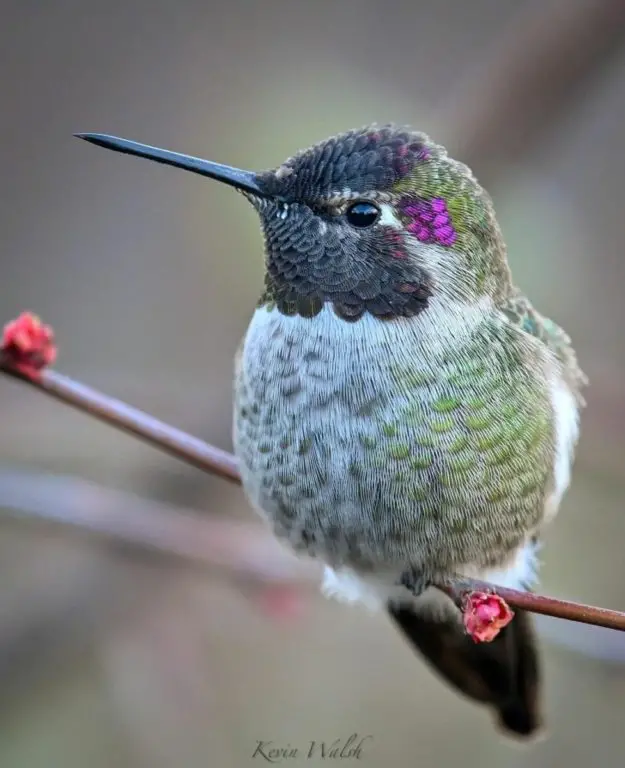
Photo by: Kevin Walsh
Note: This Juvenile Male Anna’s Hummingbird is beginning to show his magenta head feathers near his temple along with some faint color starting to show on his gorget.

Photo by: Kevin Walsh
The Anna’s hummingbird predominantly breeds in Northern Baja California and parts of Southern California, however due to the transplanting of exotic ornamental plants in residential areas along the Pacific Coast and Inland Deserts, their breeding range has expanded up the Western Seaboard. Anna’s hummingbirds have the northernmost year-round range of any hummingbird species.
Unlike many northern temperate hummingbirds, male Anna’s hummingbirds sing during courtship (though the song is so high-pitched and squeaky, it’s hard to call it singing).
Female Anna’s hummingbirds raise their young with no help from the males. Anna’s hummingbirds are commonly found nesting in Northern California climates.
See pictures of male, female and juvenile Anna‘s hummingbirds here…..
Hear sounds of Anna’s hummingbirds here…..
Allen’s Hummingbird – (Selasphorus sasin)
Conservation Status: Least concerned
Kingdom: Animalia
Phylum: Chordata
Class: Aves
Order: Apodiformes
Family: Trochilidae
Genus: Selasphorus
Species: S. sasin
Native to California, the common name of Allen’s hummingbird is in commemoration of Charles Andrew Allen (1841-1930), an American collector and taxidermist. Allen’s hummingbirds are 3.3 inches to 3.5 inches in length.
Male Allen’s hummingbirds are green-backed with a green forehead and rust-colored flanks, rump, and tail. The gorget of the male Allen’s hummingbird is an iridescent orange-red, however in darker lighting it can appear chocolate brown.
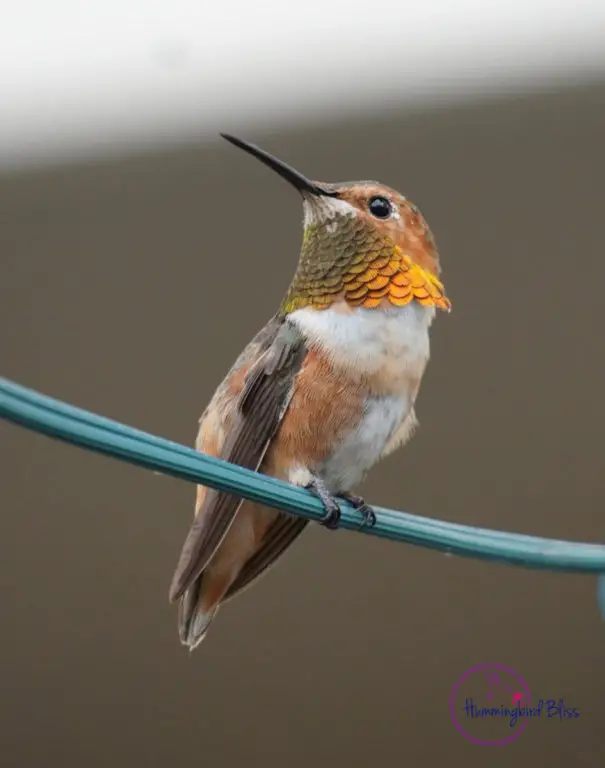
Taken: Ventura, CA

Taken: Ventura, CA
Female and juvenile Allen’s hummingbirds have similar coloring as the male, but do not have an iridescent gorget.

Taken: Ventura, CA

Taken: Ventura, CA
Juvenile Allen’s hummingbirds are so similar in coloring and temperament to a Rufous hummingbird that they are practically indistinguishable in the field. Therefore, identification is established by range rather than appearance.
Male Allen’s hummingbirds perform a striking, quick back-and-forth courtship dance resembling the movement of a pendulum. They have one of the most complex territorial dive displays of any North American hummingbird. Male Allen’s are extremely aggressive and territorial and are known to attack not only other hummingbirds of any species but also larger predatory birds such as hawks.
Male and female Allen’s hummingbirds are not social birds. They do not associate with one another outside of breeding and will fight for their own territory. They are commonly found nesting in northern California gardens.
Allen’s hummingbirds are split into native and migratory subspecies:
- Native variant (S.s. sedentarius)
- Migratory variant (S.s. sasin)
The native variant (S.s. sedentarius) lives permanently on the Channel Islands off Southern California, while the migratory variant (S.s. sasin) lives primarily on the California Coast but winters in Central Mexico.
Allen’s hummingbirds are absent at mountainous elevations above 9,000 feet due to the lack of hummingbird flowers that would otherwise serve as their nectar source.
See pictures of male, female and juvenile Allen’s hummingbirds here…..
Hear sounds of Allen’s hummingbirds here…..
Calliope Hummingbird – (Selasphorus calliope)
Conservation Status: Least concerned
Kingdom: Animalia
Phylum: Chordata
Class: Aves
Order: Apodiformes
Family: Trochilidae
Genus: Selasphorus
Species: S. calliope
Calliope hummingbirds are named after a Greek mythological muse, who represented poetry and eloquence. Calliope means “beautiful voice” in ancient Greek. Their size measures 3 inches in length.
Calliope hummingbirds are a species found in California, both as year-round natives and as seasonal migrants. Some stay in Southern California coastal areas all year, while others winter in Mexico.
Calliope hummingbirds are the smallest long-distance migratory bird in the world. All tend to breed in the higher elevations of the Rocky Mountains.
Male Calliope hummingbirds are easily identified by their iridescent purple crown and long striking spaced outline row of feathers that project down the sides of their throats. Their backs are, like many hummingbirds, metallic green.
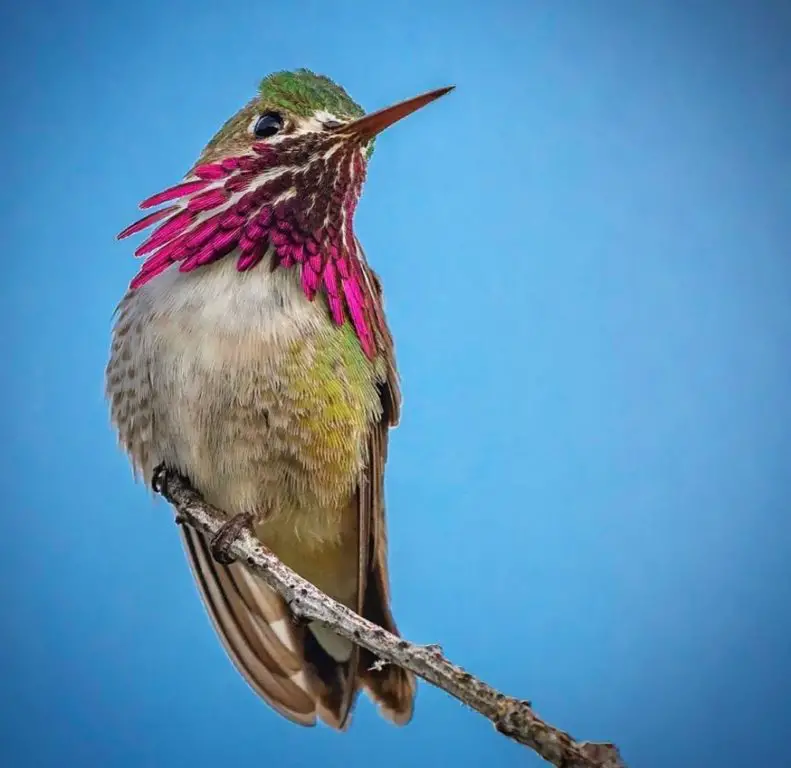
Photo by: sony_alpha_male
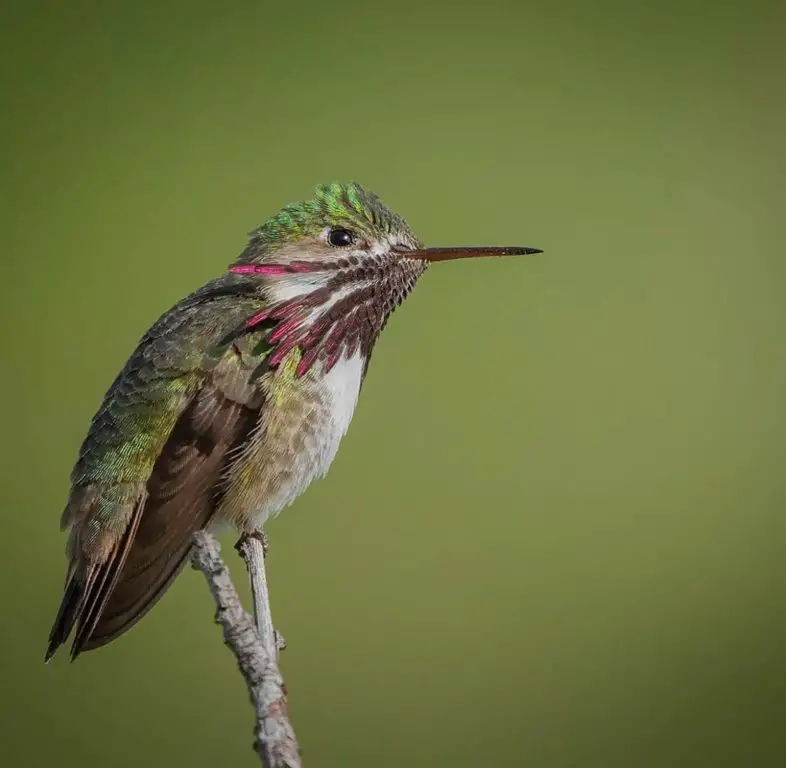
Photo by: sony_alpha_male
Female Calliopes have white underbellies and chins with a black spotting at the throat. They have gray-green crowns, and buff-colored flanks which are the underbelly or wing of a bird. Females sport dark tails with white tips.

Photo by: sony_alpha_male
Like many hummingbirds, Calliopes communicate not just by their song, but also by manipulating their feathers during flight to make different buzzing noises that act as a form of language and communication.
Male Calliope hummingbirds establish a breeding territory and mate with every available female hummingbird that accepts his courtship.
Because Calliope hummingbirds have a more restricted wintering range than most hummingbirds, they are particularly vulnerable to habitat loss and natural disasters, such as climate change and wildfires.
When a female Calliope hummingbird builds a nest they are known to both nest on the top of pine cones and to steal building materials from the nests of other birds in order to construct their own. They will also dismantle nests from previous seasons and recycle them in their new nest.
Therefore, they are often attacked and chased by larger, more aggressive species of hummingbirds, such as Allen’s and Rufous hummingbirds. This causes them to maintain a relatively low profile in comparison to other species.
See pictures of male, female and juvenile Calliope hummingbirds here…..
Hear sounds of Calliope hummingbirds here…..
Seasonal Hummingbirds:
Black-chinned Hummingbird – (Archilochus alexandri)
Conservation Status: Least concerned
Kingdom: Animalia
Phylum: Chordata
Class: Aves
Order: Apodiformes
Family: Trochilidae
Genus: Archilochus
Species: A. alexandri
One California migratory species is the Black-chinned hummingbird. It’s scientific name is in commemoration of Dr. Alexandre, a French doctor who was the first to discover the species in Mexico. Their size is 3.25 inches long.
They are sighted in California during the spring and summer. Since they are strictly migratory, even though they have a large spring and summer range over the American West, they spend the winter in Mexico.
Male Black-chinned hummingbirds are identified by their small royal purple gorget, showing a smaller glimmer of color right near the neckline of a buttoned up shirt. Since the male purple gorget or throat color is minimal, at times they can appear to look all black. They have metallic green on their backs and flanks and white on their underbelly. Their dark tail is forked and they have a black bill.

Photo by: shaunwilseyphotography
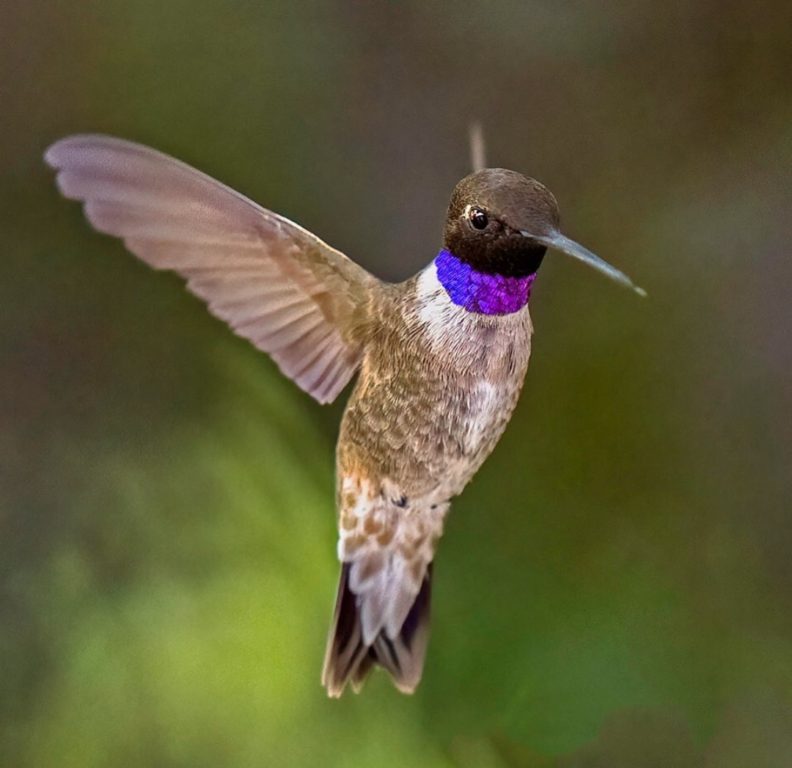
Photo by: sony_alpha_male

Photo by: hummingbirdsbysurprise
Female/immature males have a dark rounded tail with white tips and no gorget. Their head and back reflect the dull metallic marbled look of beiges, greens, whites, yellowish green and dark browns, looking similar to the scales found on a snake.
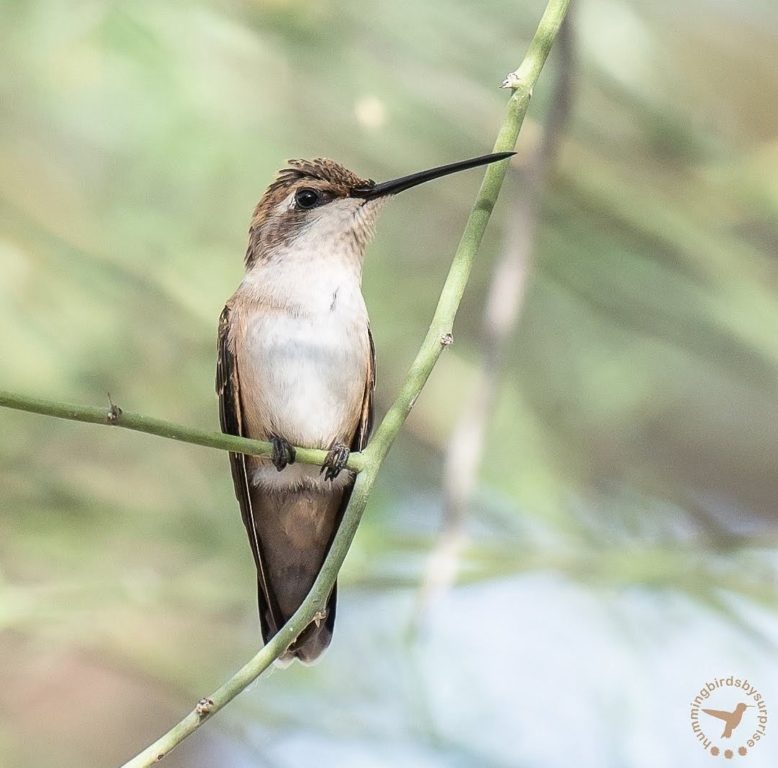
Photo by: hummingbirdsbysurprise
The coloring of juvenile Black-chinned hummingbirds is similar to that of the female adults, but with beige margins on the dorsal feathers that turn dark black when they get older.
Like Anna’s hummingbirds, Black-chinned hummingbirds hybridize, cross breeding readily with other hummingbird species.
Black-chinned hummingbirds can live up to 10 years, which is extremely long in comparison to other birds and animals of similar size.
Because of their small size, Black-chinned hummingbirds are at risk of being preyed-upon by larger insect-eating birds. Black-chinned hummingbirds are known to make their nests near larger more active bird nests, reducing the chance of predators around the nest by using a decoy strategy.
While typically a territorial species, if Black-chinned hummingbirds find themselves in an area with a large population of hummingbirds and plentiful food sources, they display little territoriality and will share.
Black-chinned hummingbirds have the smallest known genetic material of all living vertebrates or mammals.
See pictures of male, female and juvenile Black-chinned hummingbirds here…..
Hear sounds of Black-chinned hummingbirds here…..
Rufous Hummingbird – (Selasphorus rufus)
Conservation Status: Near threatened
Kingdom: Animalia
Phylum: Chordata
Class: Aves
Order: Apodiformes
Family: Trochilidae
Genus: Selasphorus
Species: S. rufous
The Rufous hummingbird gets its name from the Latin based word “red” that is used to describe its reddish-brown coloring.
A migratory bird, Rufous hummingbirds are a species found in California during the spring and summer. They spend the summer traveling through the Rocky Mountains taking advantage of the wildflower season, then migrating to Mexico to winter.
Male Rufous hummingbirds display an iridescent orange-red gorget, however in darker lighting it can appear chocolate brown. Their flanks and tail are rusty in color. They have a white to beige underbelly and a black bill. Males can also have green plumage with specks of green color on their rustic looking backs or on the crown of their head along with chocolate brown dorsal feathers. Their size is 2.8 inches to 3.5 inches in length and weigh 3.2 grams.
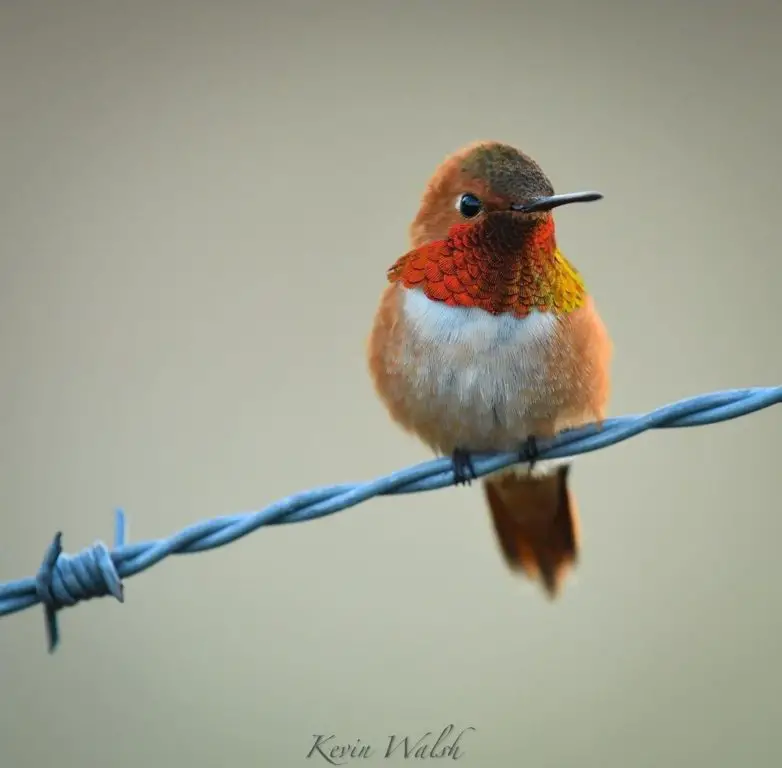
Photo by: Kevin Walsh
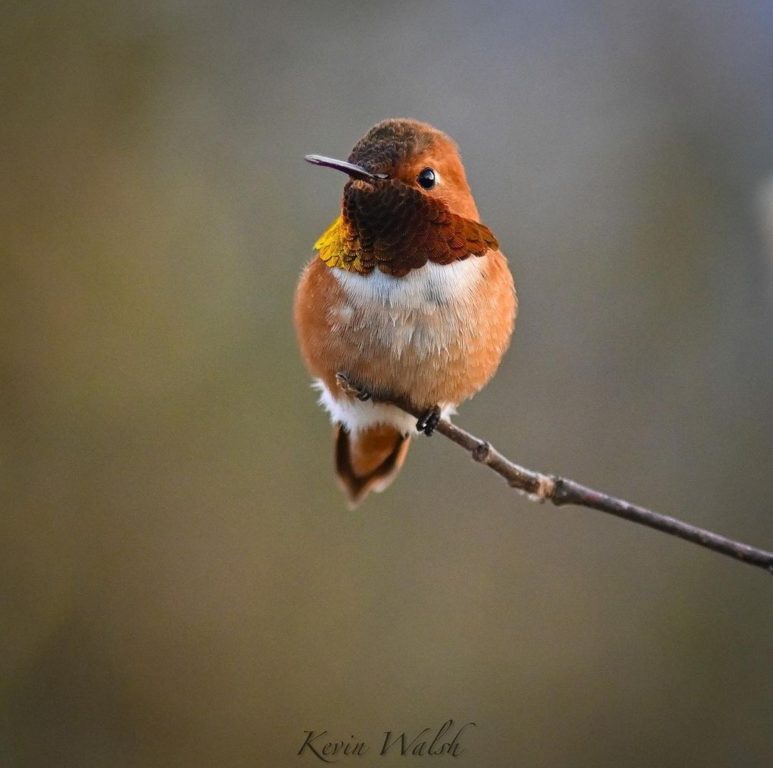
Photo by: Kevin Walsh
Juvenile male Rufous hummingbirds have a rustic look with small iridescent orange specks of color on their throats.
Juvenile Rufous hummingbirds are so similar in coloring and temperament to an Allen’s hummingbird that they are practically indistinguishable in the field. Therefore, identification is established by range rather than appearance.
Female Rufous hummingbirds are green and white with some iridescent orange feathers on their throat. Their tail is dark with white tips and an orange-red base. Female Rufous hummingbirds are slightly larger than the males in anticipation of producing offspring.
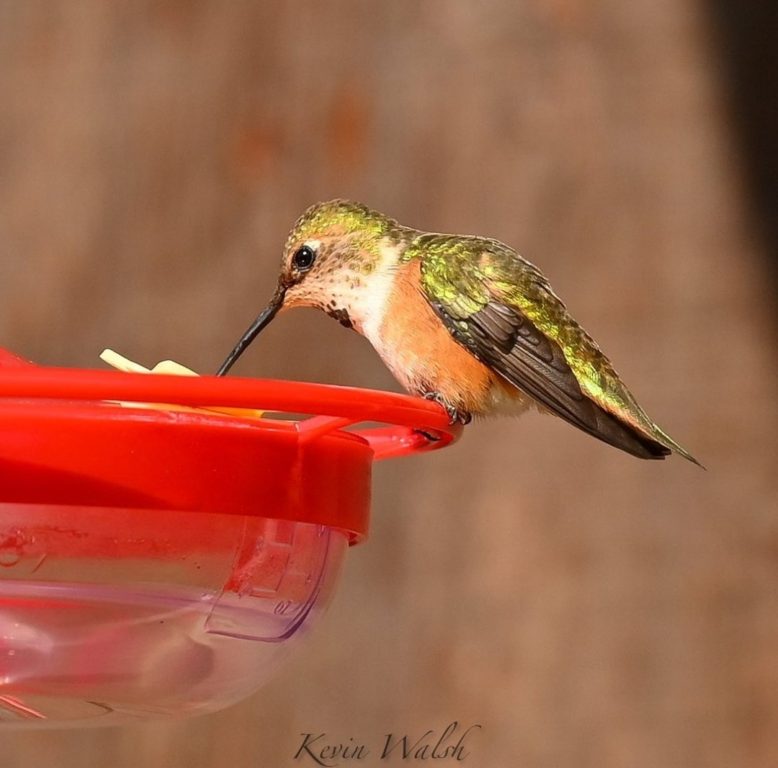
Photo by: Kevin Walsh
Like Allen’s hummingbirds, Rufous hummingbirds are highly territorial and can be aggressive to other hummingbirds and animals. They even go as far as to attack squirrels and chipmunks that come too close to their nest. They can outmaneuver all other hummingbirds in the air, making them extremely competitive at feeders.
Rufous hummingbirds make the longest migrations of any other bird in the world, making a clockwise circuit of western America every year that is approximately 3,900 miles. They have one of the northernmost breeding ranges of any hummingbird in the world, nesting as far north as Alaska. Rufous hummingbirds are polygamous and will mate with several partners in a season.
Rufous hummingbirds have excellent memories and have been known to investigate the location of an old hummingbird feeder years after the feeder has been removed.
During a capture and release banding operation in British Columbia, the oldest living recorded female Rufous hummingbird was 8 years and 11 months old.
See my article: 3 Reasons Why Hummingbirds Are Banded
Due to habitat loss in the Pacific Northwest, Rufous hummingbirds are listed at “near threatened” status by the IUCN red list of threatened species.
See pictures of male, female and juvenile Rufous hummingbirds here…..
Hear sounds of Rufous hummingbirds here…..
Costa’s Hummingbird – (Calypte costae)
Conservation Status: Least concerned
Kingdom: Animalia
Phylum: Chordata
Class: Aves
Order: Apodiformes
Family: Trochilidae
Genus: Calypte
Species: C. costae
Costa’s hummingbird was named in 1839 by Jules Bourcier to commemorate Louis Marie Pantaleon Costa, the French ornithologist who was an avid collector of hummingbirds.
Very little is known about Costa’s hummingbirds and their short migratory habits in comparison to other hummingbird species. We do know that they are a very coastal bird and only move inland to breed and are found in California, both as migrants and vagrants. This species is 3-3.5 inches in length.
Male Costa’s have a bright reddish-purple cap and gorget or just their gorget with long streaming throat feathers that stick out looking like a mens freshly pressed shirt collar, similar to a Calliope hummingbird. They also have green backs and flanks, small black tails and wings, and patches of white on their throat and tail.
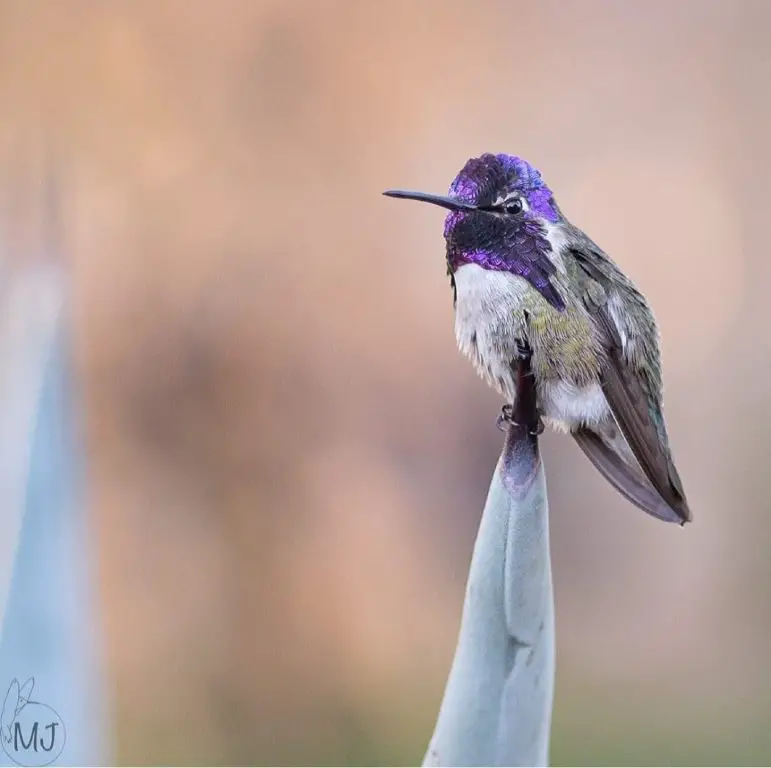
Photo by: hummingbirdsbysuprise
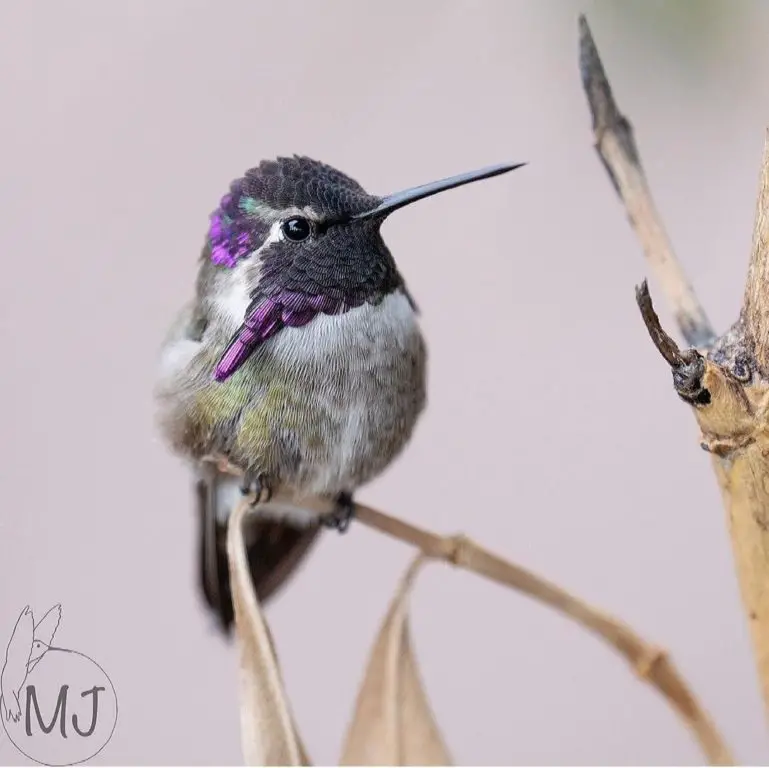
Photo by: hummingbirdsbysuprise
Adult female Costa’s hummingbirds are not as vibrant and display in color, a grayish-light green back with a dusty white underbelly.

Photo by: hummingbirdsbysuprise
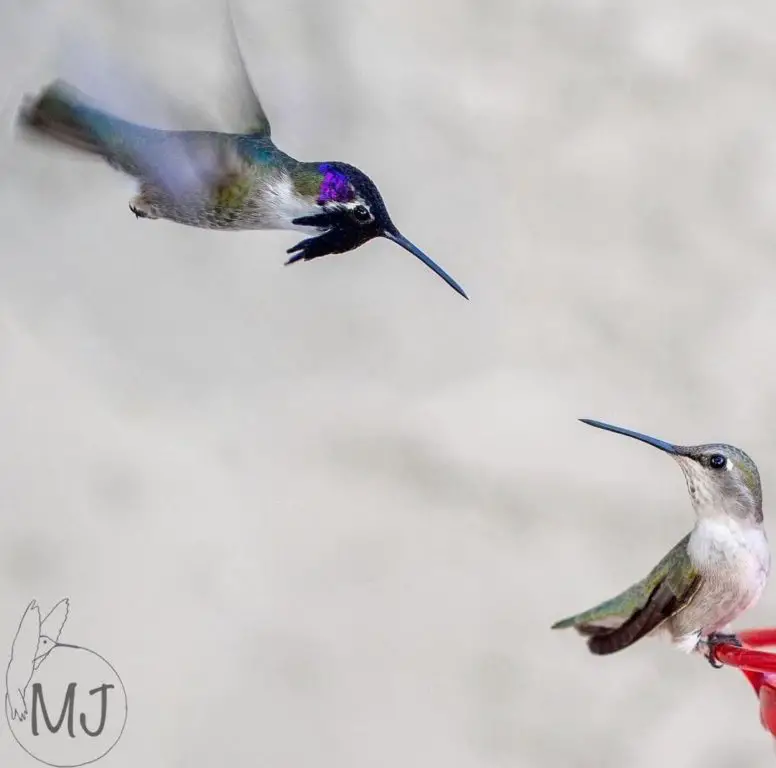
Photo by: hummingbirdsbysuprise
Note: Defending feeders are taken seriously!
See my article: Why Hummingbirds Chase Each Other: Is it Friend or Foe?
Costa’s hummingbirds are a desert-dwelling species, found in the scrub of the Sonoran and Mojave deserts as well as the chaparral scrub of coastal California and the desert scrub of Baja California, Mexico.
Unlike some hummingbirds, Costa’s hummingbirds tend to build their nests in open areas, without much vegetative cover and have been known to nest on the tops of cacti. The thorns of the plant act as a deterrent to predators that might attempt to eat the eggs or nestlings.
Although Costa’s hummingbirds will defend nectar sources amongst themselves, they are subordinate to larger hummingbirds and will defer to them if challenged.
These hummingbirds have no known predators, however, the largest threat to Costa’s hummingbirds is human encroachment in the form of desert scrub cleared for settlement and grazing.
See pictures of male, female and juvenile Costa’s hummingbirds here…..
Hear sounds of Costa’s hummingbirds here…..
Green-violetears Hummingbird – (Colibri thalassinus)
Conservation Status: Least concerned
Kingdom: Animalia
Phylum: Chordata
Class: Aves
Order: Apodiformes
Family: Trochilidae
Genus: Colibri
Species: C. thalassinus / Mexican violetear
The Green-violetears or Mexican-violetears (Violet-ear) hummingbirds get its name from the Latin word thalassinus meaning “color of the sea”. They are a rare but annual non-breeding visitor to the United States and an annual visitor to Southern California. They are typically 3.8 to 4.7 inches in length.
Green-violetear hummingbirds is an iridescent green hummingbird with bright violet ear patches on the sides of its neck (hence the name “violet ears”). The tail of this hummingbird is metallic blue-green with bronze central tail feathers that feature a black band underneath.
These species of hummingbird are found on the edge of cloud forests from Mexico to Nicaragua, where they enjoy a high level of tropical humidity in their environment. This dark hummingbird is commonly seen in forest clearings and edges moving among mountain ranges.
Green-violetear hummingbirds are somewhat nomadic. Scientists do not know much about their migration patterns as they have not been well-studied. But of the data that has been collected, the Mexican Violetear is typically found in central Mexico, Central America, and northern South America.
While mostly a permanent resident throughout its normal range, individuals seem to wander widely and reach the California area and are noted every year. Mexican-violetears are found in Texas, and individual birds have strayed as far north as Wisconsin, Michigan, and even Canada.
Like many other kinds of hummingbirds, the Green-violetears hummingbird is a solitary nester. They forage for nectar and insects alone rather than in a flock, but groups of these hummingbirds can be seen around flowering trees, such as the coffee-shade Inga tree.
See pictures of Mexican violet-ear hummingbirds here…..
Hear sounds of Mexican violet-ear hummingbirds here…..
Violet-crowned Hummingbird – (Amazilia voliceps)
Conservation Status: Least concerned
Kingdom: Animalia
Phylum: Chordata
Class: Aves
Order: Apodiformes
Family: Trochilidae
Genus: Amazilia
Species: A. voliceps
Violet-crowned hummingbirds are a species that sometimes migrate into California therefore reside in the vagrant category. They derive their name from the bright purple cap of feathers on its head known as a crown. These hummingbirds are 3 to 3.9 inches in length.
Male Violet-crowned hummingbirds have a reddish/orange beak with a noticeable black spot at the tip. Their cap of feathers on their head looks like they are hiding behind an iridescent violet/blue mask from Zorro. They have olive green on their topsides with a distinguishable bright white belly covering the bottom of their beak to the full length of their body.
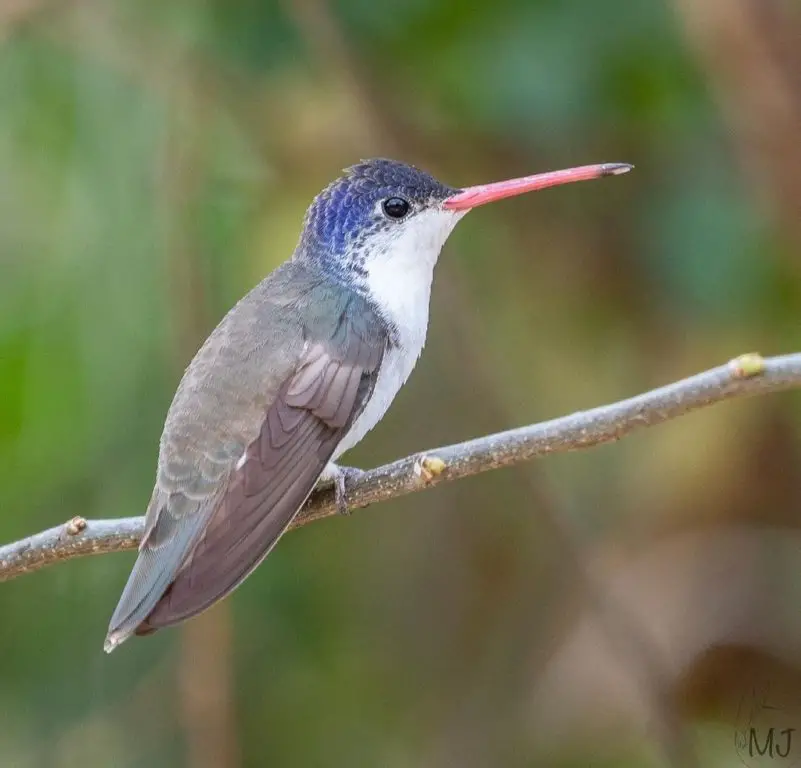
Photo by: hummingbirdsbysuprise
Unlike many hummingbird species, Violet-crowned hummingbirds have neither a gorget nor ear patch markings. The females as usual are drabber looking than the males.
Violet-crowned hummingbirds prefer a riparian habitat, which means they can be found in woodland areas near rivers. However, they are also spotted visiting California primarily hanging around hummingbird feeders. They are particular about their breeding environment and prefer to nest almost exclusively in the Arizona sycamore trees.
There is an increase in these hummingbirds overwintering in the Southern United State increasing its habitat range annually as it moves north.
See pictures of Violet-crowned hummingbirds here…..
Hear sounds of Violet-crowned hummingbirds here…..
Rare/Vagrants Hummingbirds
Broad-billed Hummingbird – (Cynanthus latirostris)
Conservation Status: Least concerned
Kingdom: Animalia
Phylum: Chordata
Class: Aves
Order: Apodiformes
Family: Trochilidae
Genus: Cynanthus
Species: C. latirostris
Broad-billed hummingbirds are primarily located in Mexico. They are also found in California as a “stray” or “vagrant” when they wander through their breeding grounds and outside their designated range reaching the mountains and canyons of the southwestern United States. Most of their population stays year-round in Mexico and Central America, they are only considered partially migratory. A few remain year-round in the United States, usually very near the Mexican border.
Male Broad-billed hummingbirds feature a bright blue/green gorget that spreads back towards its shoulders. Juvenile males show off a full charcoal dark grey body with flecks of metallic blue on their throat and a light green neck and backside. They sport a bright orange-red beak with a signature long black tip.
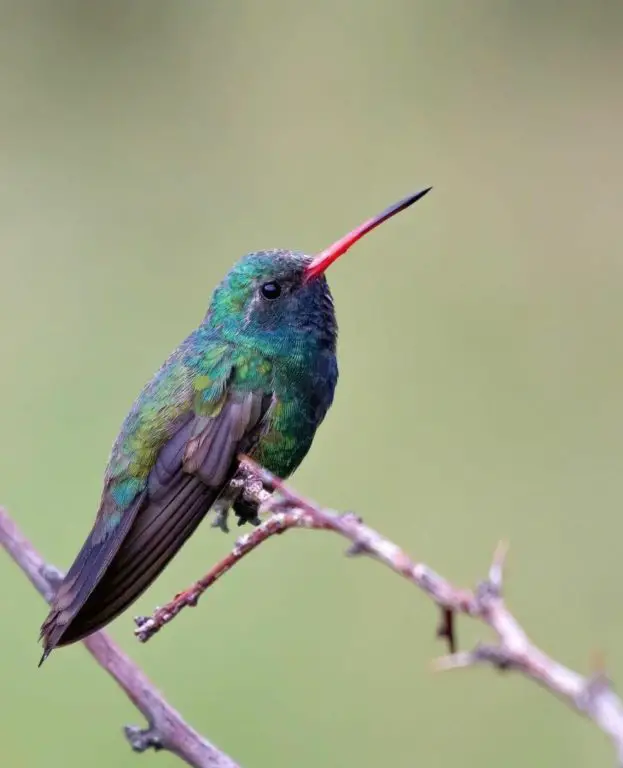
Photo by: Aaron Gomperts
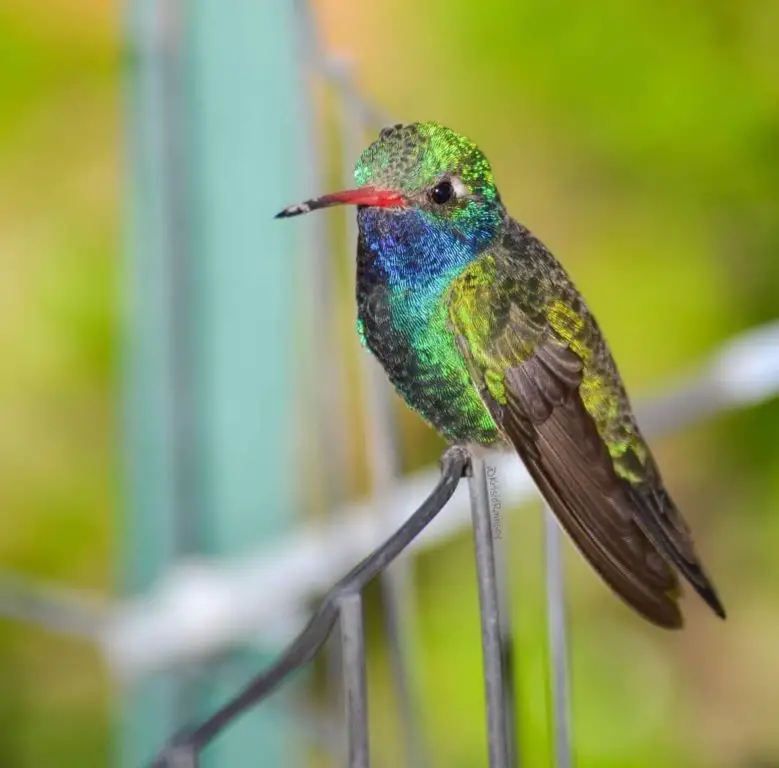
Photo by: krisieramsey
Both juvenile male and female Broad-billed hummingbirds are predominantly metallic green on their topside with a white underbelly. Their tails are dark in color and forked.
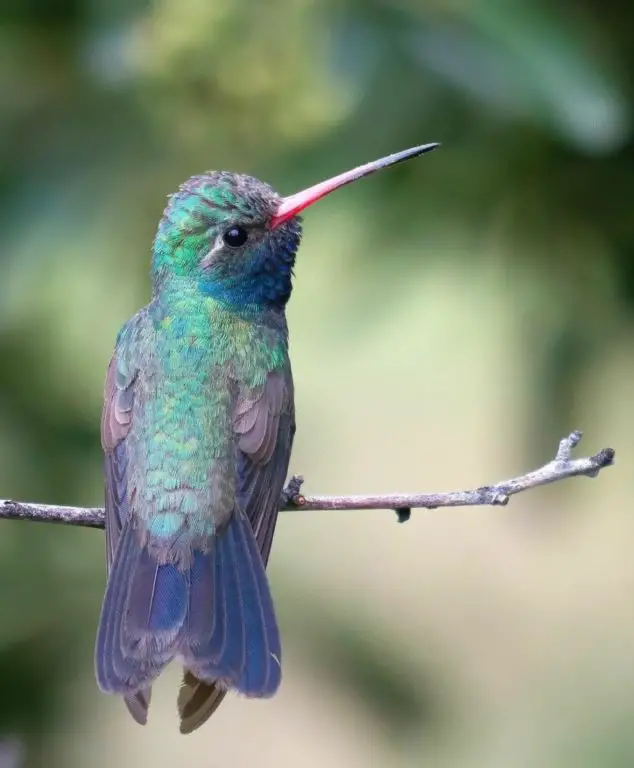
Photo by: Aaron Gomperts
The females have a fully colored dark bill and a white accent line above their eyes.
Astonishingly, unlike other hummingbirds population counts, the Broad-billed hummingbirds show an actual increase in their population in recent years.
Broad-billed hummingbird nests are distinguishable because they do not decorate the outside of their nests with lichens and instead choose to construct their nests with mostly outside grass fibers, bits of leaves and bark while using spider webs to glue and hold the nest together. The female builds her nest hanging on a single long slender branch.
See pictures of male, female, and juvenile Broad-billed hummingbirds here…..
Hear sounds of Broad-billed hummingbirds here…..
Xantus’s Hummingbird – (Hylocharis xantusii)
Conservation Status: Least concerned
Kingdom: Animalia
Phylum: Chordata
Class: Aves
Order: Apodiformes
Family: Trochilidae
Genus: Hylocharis
Species: H. xantusii
The Xanthus’s hummingbird was named to commemorate a Hungarian zoologist, John Xantus de Vesey (1824-1894). Their size ranges from 3 inches to 3.5 inches in length and weighs 3-4 ounces, the weight of 3-4 pencils.
Like many other male hummingbirds, Xantus’s hummingbirds feature a crown and gorget, of dark iridescent green that can appear black depending on the lighting.
Adults are green on their topside and feature a dark reddish-brown tail with faint black tips. The easiest identifiable mark on the Xantus’s hummingbird is the prominent white strip above the eye streaking down each side of the hummingbird’s face. Both sexes also have cinnamon brown underbellies.
Xantus’s hummingbirds are a hummingbird species primarily found in Baja California, but occasionally turn up as “vagrants” when they wander from their breeding grounds into Southern California and the Pacific coastline. This makes them a rare treat for birdwatchers in California who are able to catch a glimpse of a Xantus’s hummingbird in their yard.
Vagrant Xantus’s hummingbirds have been found wandering as far north as British Columbia, far outside their typical Baja habitats. The Xantus’s hummingbird is the only hummingbird regularly seen or endemic to Baja California.
A spotting of a female Xantus hummingbird has been documented to have migrated further north of Ventura California and was able to build a nest and lay her eggs successfully, but unfortunately they were unable to hatch even with all of her hard work and determination.
See pictures of Xantus’s hummingbirds here…..
Hear sounds of Xantus’s hummingbirds here…..
Blue-throated Hummingbird – (Lampornis clemenciae)
Conservation Status: Least concerned
Kingdom: Animalia
Phylum: Chordata
Class: Aves
Order: Apodiformes
Family: Trochilidae
Genus: Lampornis
Species: L. clemenciae
The Blue-throated Hummingbird (also known as a blue-throated mountain-gem) is a large hummingbird that is 4.5 to 4.9 inches in length. This hummingbird is sometimes found as a vagrant visitor in California. They are also found in the mountain ranges of Arizona and Texas.
The male Blue-throated hummingbird features a bright iridescent cobalt blue gorget, and dramatic white stripes over both of its eyes. His wings and tail are dark with the tips of his tail painted white. Blue-throated hummingbirds expose a dull greenish-gray color all over its body emphasizing more patches of a grayish-emerald green on their head, neck and the top part of the shoulder where the wing attaches.
Partially because of their large size, Blue-throated hummingbirds have the slowest recorded wingbeat rate of any known hummingbird. It takes a lot longer and more effort for a hummingbird with an extended wingspan to flap their wings in a figure eight motion than it does for a smaller, more petite hummingbird. Think of it visually on a larger scale between a Bald eagle’s wingspan ranging between 5.9-7.5ft in length and a crow ranging between 2.8-3.3 ft in length. It takes more motion effort for one than the other.
Blue-throated hummingbirds are mountainous birds that prefer to nest on rock overhangs or on human residential structures. They are known to return to the same nest each year, stacking new nests on top of old nests until they resemble a tall tower.
Blue-throated hummingbirds become aggressive and territorial over flower types with a higher sugar content and will violently defend them from invaders, which is typical for most hummingbirds. They are heavily insectivorous due to the energy necessities of their size, and as a result, eat more insects than any other hummingbird species.
See pictures of male, female, and juvenile Blue-throated hummingbirds here…..
Hear sounds of Blue-throated hummingbirds here…..
Rivoli’s Hummingbird – (Eugenes fulgens)
Conservation Status: Least concerned
Kingdom: Animalia
Phylum: Chordata
Class: Aves
Order: Apodiformes
Family: Trochilidae
Genus: Eugenes
Species: E. Fulgens
The Rivoli’s hummingbird (pronounced: rivo-lee) has undergone several name changes, being changed to the “Magnificent Hummingbird” in 1983 then to “Refulgent Hummingbird” only to have the “Rivoli’s Hummingbird” name return in 2017 when the species was split into two variations (Rivoli’s and Talamanca). Rivoli’s Hummingbird is named in honor of Francois Victor Massena, the Duke of Rivoli, by the ornithologist Rene-Primevera Lesson.
The Rivoli’s hummingbirds are normally found in the mountainous areas of Arizona, New Mexico, and Central America, but are seen as vagrants in California. They prefer to live in ravines while feeding in open meadows and will nest in trees overhanging streams and creeks.
These hummingbirds are somewhat dark in color except when they are shown in bright daylight, where their violet crown, bright blue-green gorget, and white eyespots are more apparent through iridescence. They are 4.3 to 5.5 inches in length.

Photo by: TheHummingbirdGuy
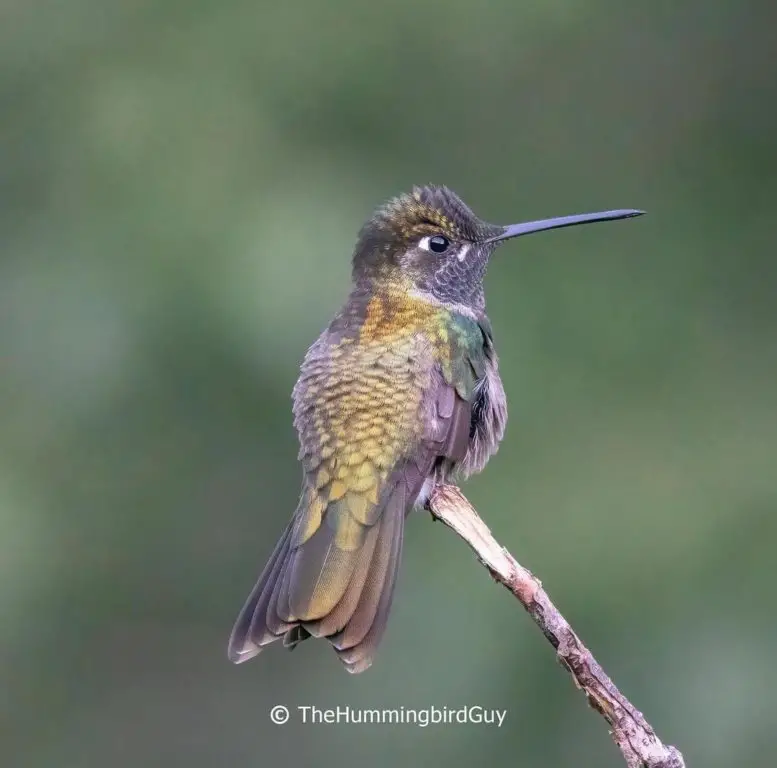
Photo by: TheHummingbirdGuy
They have the highest recorded heart rate of any living vertebrate ranging from 420 to 1,200 beats per minute.
Rivoli’s hummingbirds are known for hybridizing with other species of hummingbirds in the southernmost reaches of its habitat range.
See pictures of male, female, and juvenile Rivoli’s hummingbirds here…..
Hear sounds of Rivoli’s hummingbirds here…..
Ruby-throated Hummingbird – (Archilochus colubris)
Conservation Status: Least concerned
Kingdom: Animalia
Phylum: Chordata
Class: Aves
Order: Apodiformes
Family: Trochilidae
Genus: Archilochus
Species: A. colubris
Ruby-throated hummingbirds are seen on the eastern side of North America but sometimes spotted in California as a vagrant. The Ruby-throated hummingbird is a smaller species of hummingbirds at 2.8 to 3.3 inches in length.
Male Ruby-throated hummingbirds have striking ruby-colored gorgets and wear a duller metallic green topside with a light gray underbelly and black wings. Their lifespan is approximately 5 years.

Photo by: paulapaintsart
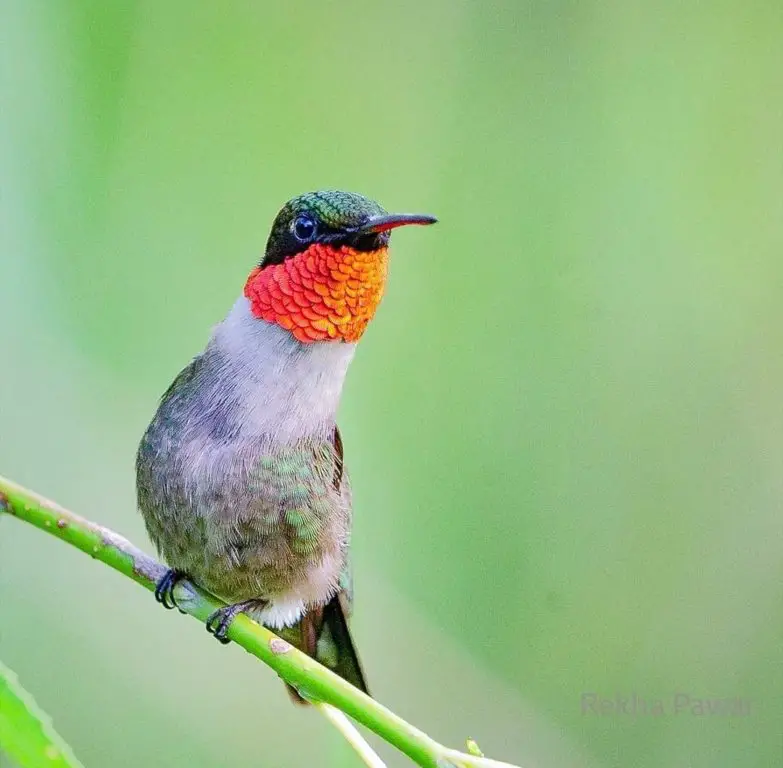
Photo by: Rekha Pawar
Female Ruby-throated hummingbirds have a white throat with some light stippling and are typically larger than the males. The oldest female Ruby-throated hummingbird has been recorded at 9 years, almost double that of the male.
However, the average lifespan of a Ruby-throated hummingbird is approximately 3-5 years.

Photo by: dgen.photos
Juvenile male and female Ruby-throated hummingbirds during their initial stages of life resemble their mother exhibiting a white throat with light stippling.
As the males mature, they begin to display a few specks of color near their neckline and eventually their bolder red throat feathers become more dominant and stately displaying a colorful gorget.
Juvenile females show a light faint grey stippling on their throat. As both sexes mature their less vivid and lighter colored plumage will begin to mature and become darker in color.
Note: In both pictures below the newly white fluffy down feathers on this baby/juvenile Ruby-throated hummingbird’s bottom. Also notice the nice fat reserves they accumulated by being fed by their diligent mother which will sustain it through adolescence.
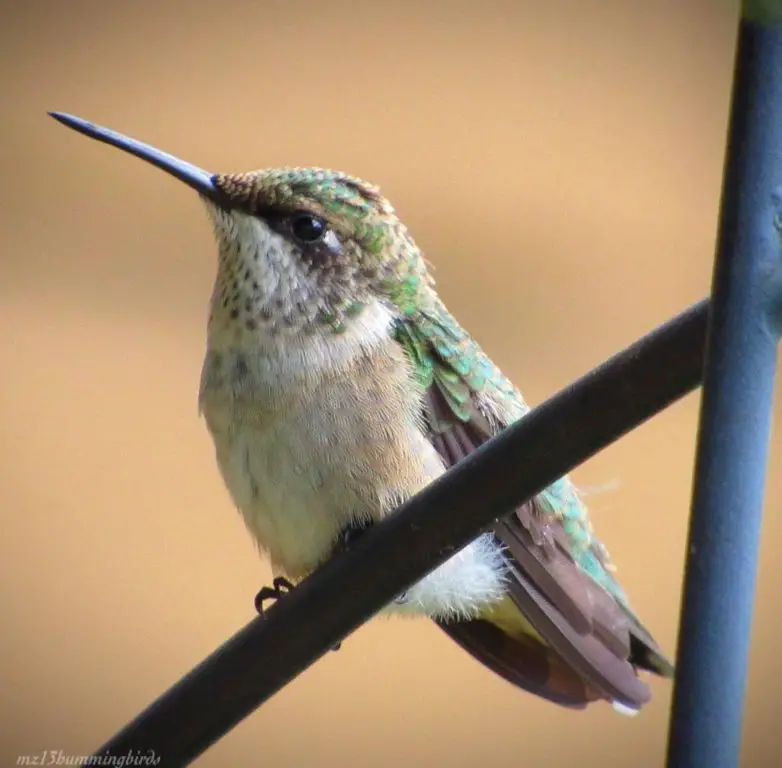
Photo by: mz13hummingbirds
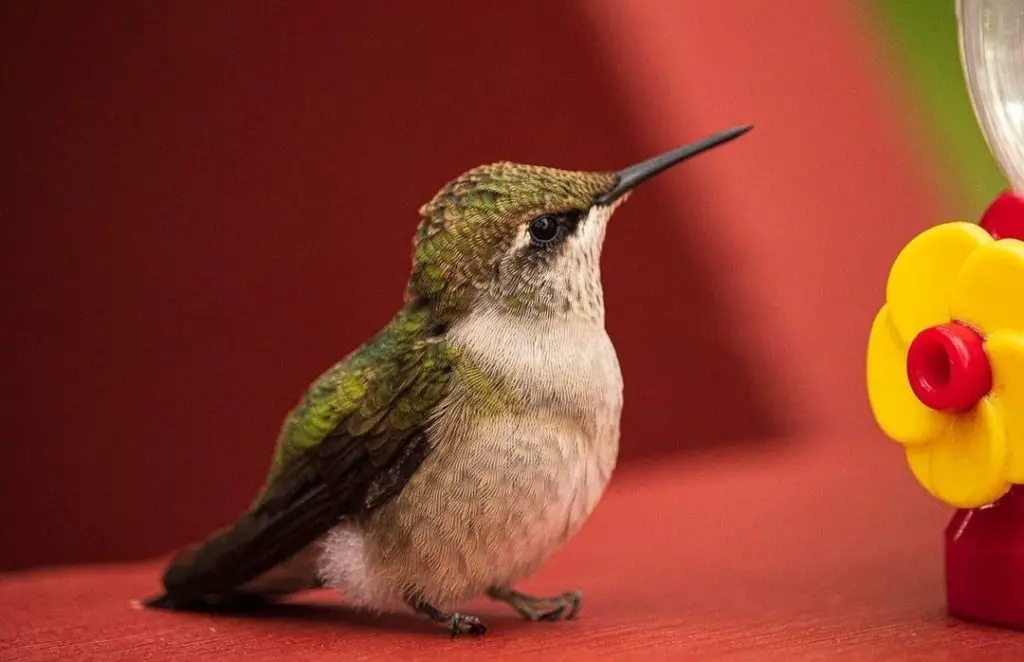
Photo by: MaryLou Ziebarth
Researchers believe their small size makes the energy expenditure of their grueling trans-oceanic migration pattern more taxing for males than for females even though they both double their body’s fat prior to making the migration across the Gulf of Mexico.
Ruby-throated hummingbirds prefer open woodland and are often seen in parks, gardens, and backyards as well. They are solitary birds except during mating periods when they are fiercely territorial and aggressive towards hummingbirds of other species. Even though these hummingbirds have an aggressive side they can still be eaten by predators such as large invertebrates, praying mantises, orb-weaver spiders, and dragonflies.
See pictures of male, female, and juvenile Ruby-throated hummingbirds here…..
Hear sounds of Ruby-throated hummingbirds here…..
Broad-tailed Hummingbird – (Selsaphoris platycercus)
Conservation Status: Least concerned
Kingdom: Animalia
Phylum: Chordata
Class: Aves
Order: Apodiformes
Family: Trochilidae
Genus: Selsaphoris
Species: S. platycercus
The Broad-tailed hummingbird is a medium-sized hummingbird at 4 inches in length and is sometimes found as a vagrant visitor to California, though it usually resides in Mexico and Guatemala.
Broad-tailed hummingbirds are similar-looking to Calliope hummingbirds, with males having an iridescent ruby-red gorget. Both males and females have green topside and pale underbellies with bright white eye rings and broad rounded tails.
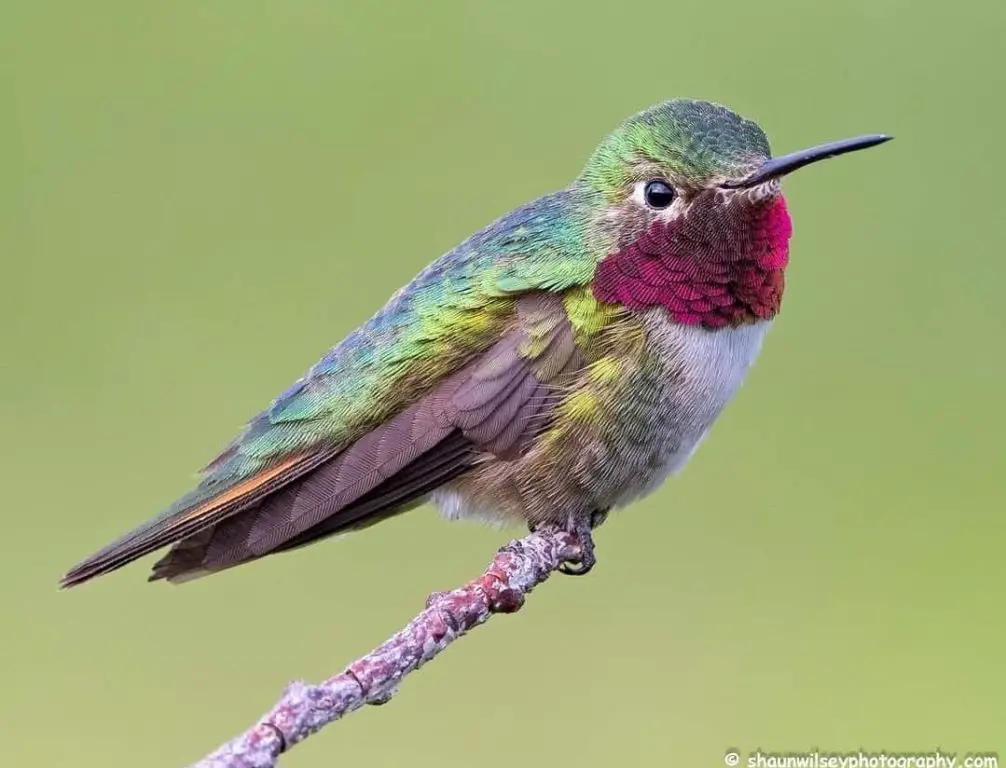
Photo by: shaunwilseyphotography
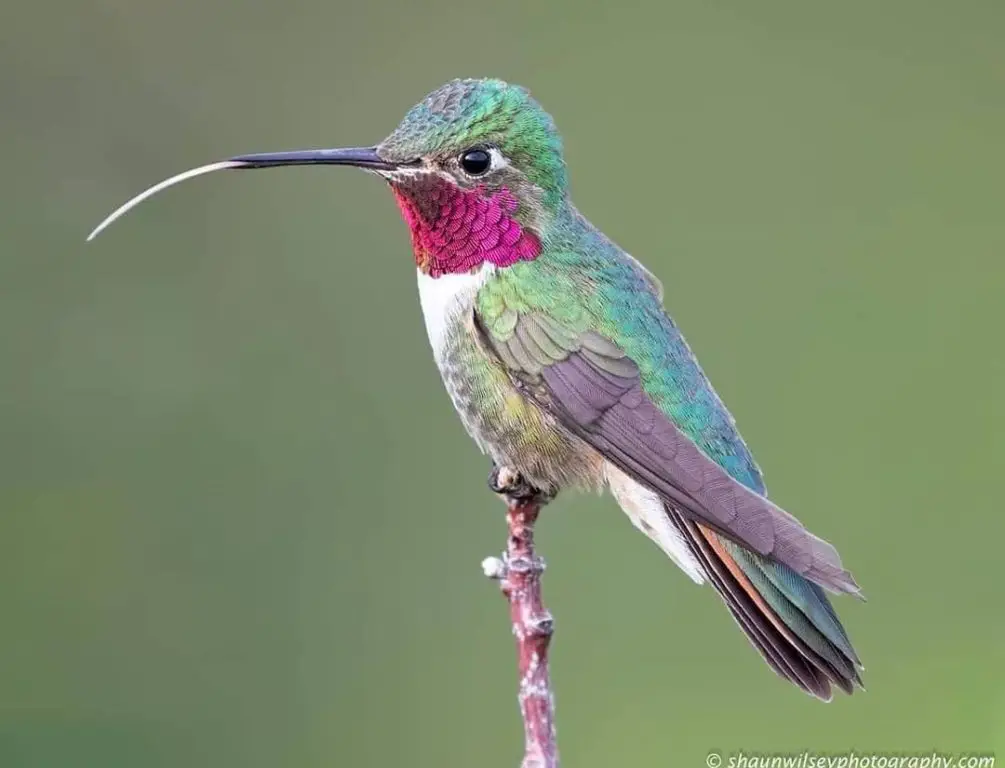
Photo by: shaunwilseyphotography
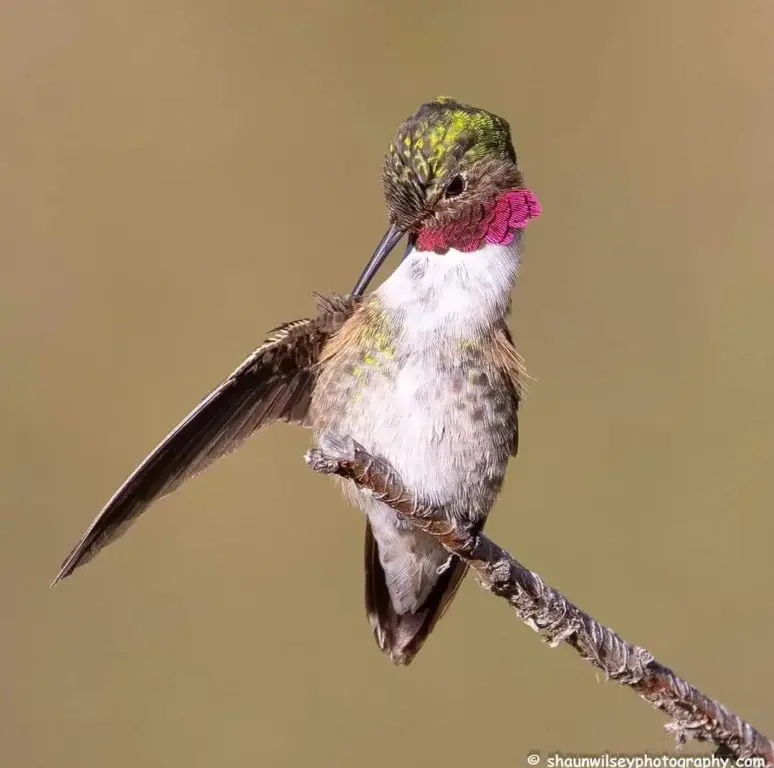
Photo by: shaunwilseyphotography
Note: Preening flight feathers is an important daily routine to maintain hygiene and to keep the feathers flexible, strong, in alignment, and parasite-free.
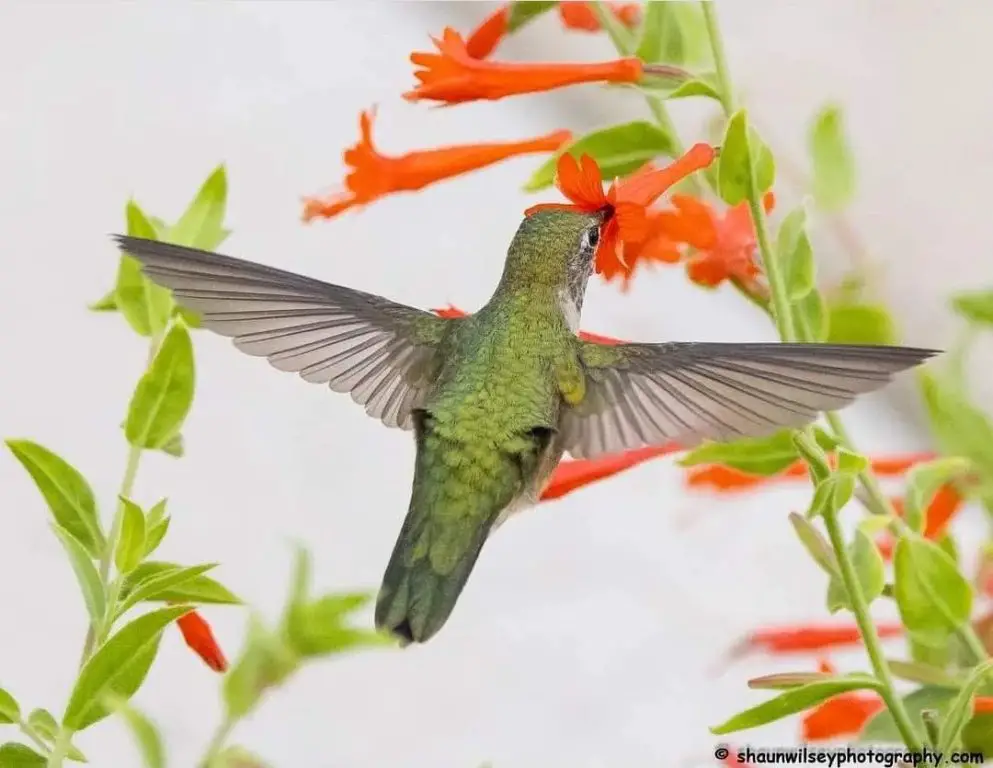
Photo by: shaunwilseyphotography
Note: Hummingbirds beat their wings 80 beats per second. While hovering, the wings move back and forth forming a figure eight or infinity symbol. This powerful movement creates a fanning effect as noticed by the ruffling feathers on both sides of her lower back.
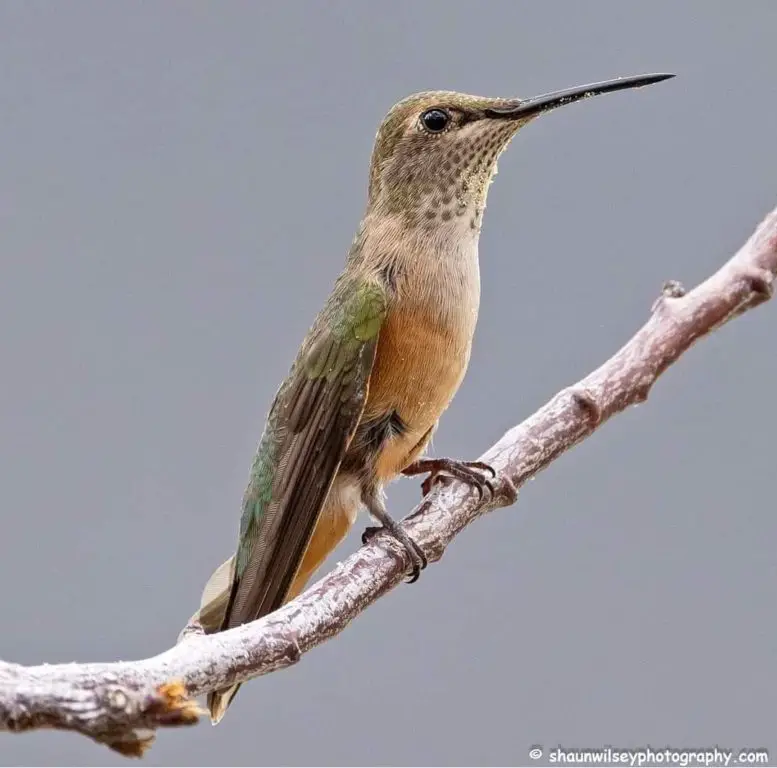
Photo by: shaunwilseyphotography
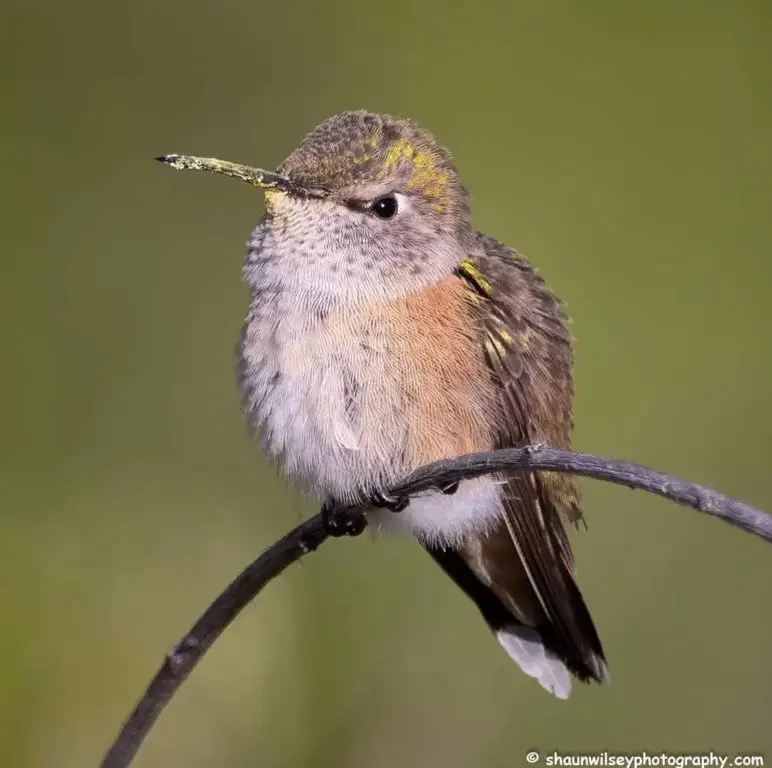
Photo by: shaunwilseyphotography
Note: The newly white fluffy down feathers on this baby/juvenile Broad-tailed hummingbird’s bottom. Also, notice the nice fat reserves they have accumulated by being fed by their diligent mother which will sustain them through adolescence.
This species of hummingbird prefers habitats in the understory of mature forest woodlands such as pine and oak groves. They chose to nest on the branches of trees and have been known to return to the same nesting ground each year, roughly 70% of the time. Their breeding time coincides with the peak time of flowering native plants for maximum food resource availability. They are promiscuous and do not form any kind of a pair bond between male and female birds and again the female raises the young alone.
The Broad-tailed hummingbird has suffered a decline in population since the 1990’s, but presently, its population is stable, and it has been shown to have adapted to human habitat encroachment.
See pictures of male, female, and juvenile Broad-tailed hummingbirds here…..
Hear sounds of Broad-tailed hummingbirds here…..
Keep your eyes peeled and observe and enjoy the multiple types of hummingbirds found in California!
See my article: Hummingbird Migration in California
Happy Hummingbird Watching!

Photo by: rwm_inthewild
Taken: Menlo Park, CA
Backyard Visitors is a participant in the Amazon Services LLC Associates Program, an affiliate advertising program designed to provide a means for sites to earn advertising fees by advertising and linking to Amazon.com. We also participate in other affiliate programs which compensate us for referring traffic.

